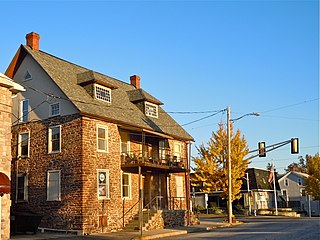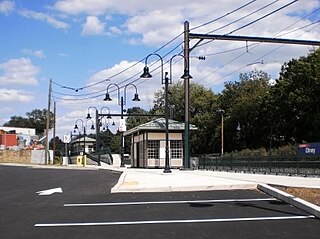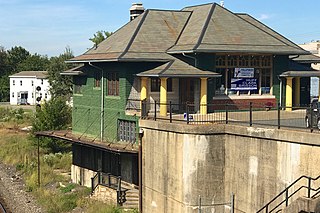
Souderton is a borough in Montgomery County, Pennsylvania, United States. The population was 7,246 in 2022 according to the Census Bureau.

The Aldene Connection is a connection between two railroad lines in the Aldene neighborhood of Roselle Park, New Jersey, United States, one formerly belonging to the Central Railroad of New Jersey (CNJ), the other formerly of the Lehigh Valley Railroad. The connections allow trains on the New Jersey Transit Raritan Valley Line to travel from Cranford and points west through stations in Roselle Park and Union to the Hunter Connection in Newark, which in turn allows access to the Northeast Corridor and Newark Penn Station.
The Wheeling and Lake Erie Railway is a Class II regional railroad that provides freight service, mainly in the areas of Northern Ohio and Western Pennsylvania. It took its name from the former Wheeling and Lake Erie Railway, most of which it bought from the Norfolk and Western Railway in 1990.
Buckingham Branch Railroad is a Class III short-line railroad operating over 275 miles (443 km) of historic and strategic trackage in Central Virginia. Sharing overhead traffic with CSX and Amtrak, the company's headquarters are in Dillwyn, Virginia in the former Chesapeake and Ohio Railroad (C&O) station, itself a historic landmark in the community. The railroad was featured in the January 2012 issue of Trains Magazine. It is referenced in the How It’s Made episode “Railway Bridge Ties”, showing it crossing a curved bridge.

Miquon station is a suburban commuter railroad station on the SEPTA Manayunk/Norristown Line, located at River and Manor Roads in the Miquon section of Whitemarsh Township, Montgomery County, Pennsylvania, United States. It is the first station on the line outside Philadelphia.
The New Hope Railroad, formerly and colloquially known as the New Hope and Ivyland Railroad, is a shortline and heritage railroad located in New Hope, Pennsylvania. Today, the railroad operates both steam and diesel powered locomotives and is an associate member of NORAC.

Olney station is a SEPTA Regional Rail station in Philadelphia, Pennsylvania. Located at Mascher Street and Tabor Road in the Olney neighborhood, it serves the Fox Chase Line. The station has a 61-space parking lot. In FY 2013, it had a weekday average of 158 boardings and 156 alightings.

The Far Rockaway Branch is an electrified rail line and service owned and operated by the Long Island Rail Road in the U.S. state of New York. The branch begins at Valley Interlocking, just east of Valley Stream station. From Valley Stream, the line heads south and southwest through southwestern Nassau County, ending at Far Rockaway in Queens, thus reentering New York City. LIRR maps and schedules indicate that the Far Rockaway Branch service continues west along the Atlantic Branch to Jamaica. This two-track branch provides all day service in both directions to Grand Central Madison and Penn Station, both in Midtown Manhattan

Wyndmoor station is a SEPTA Regional Rail station at 256 East Willow Grove Avenue at Wyndmoor Street in the Chestnut Hill region of Philadelphia, Pennsylvania.

The Electric City Trolley Museum is a transport museum located in downtown Scranton, Pennsylvania, next to the Steamtown National Historic Site. The museum displays and operates restored trolleys and interurbans on former lines of the Lackawanna and Wyoming Valley Railroad, which are now owned by the government of Lackawanna County and operated by the Delaware-Lackawanna Railroad.

Cresheim Creek is a creek in southeastern Pennsylvania. Rising at Wyndmoor in Springfield Township, it runs about 2.7 miles (4.3 km) southwest, passing through part of Northwest Philadelphia and forming the boundary between Mount Airy and Chestnut Hill, before emptying into the Wissahickon Creek at Devil's Pool not far south of the Valley Green Inn.

The Wanamaker, Kempton & Southern, Inc. (WK&S) is a privately owned heritage railroad company in Kempton, Pennsylvania. The company was founded in 1963 and operates over an isolated remnant of a former Reading Company line. Its nickname is the Hawk Mountain Line due to its proximity to the Hawk Mountain range.

Fairmount Avenue is a former New Jersey Transit rail station on the Pascack Valley Line. The station was one of three rail stations in Hackensack, New Jersey, and was located at Fairmount Avenue and Temple Avenue. The Essex Street and Anderson Street stations are also located in Hackensack. The station house was built in 1870 as part of the extension railroad for the Hackensack and New York Railroad on a track extension from Anderson Street in Hackensack. The line became part of the Erie Railroad in 1896 and New Jersey Transit in 1983.

The Lehigh Line is a railroad line in Central New Jersey, Northeastern Pennsylvania, and the Lehigh Valley region of eastern Pennsylvania. It is owned and operated by the Norfolk Southern Railway. The line runs west from the vicinity of the Port of New York and New Jersey in Manville, New Jersey via Conrail's Lehigh Line to the southern end of Wyoming Valley's Coal Region in Lehigh Township, Pennsylvania.

Phillipsburg Union Station is an active railroad station museum, June 2023, in Phillipsburg, New Jersey, United States, at 178 South Main Street. Opened in 1914, Union Station was built by the Delaware, Lackawanna & Western Railroad (DL&W) and shared with the Central Railroad of New Jersey (CNJ) and was situated where the lines merged before the bridge crossing the Delaware River. Designed by Frank J. Nies, the architect who produced many of DL&W stations now listed state and federal registers of historic places, the 2+1⁄2 story, 3 bay brick building is unusual example of a union station and a representation of early 20th century Prairie style architecture. The Phillipsburg Union Signal Tower, or PU Tower, is nearby, also restored to its original form, and available for tours.

Rushland is a defunct station on the Reading Company's New Hope Branch, originally known as Rush Valley. The station is currently on the line used by the New Hope Railroad. The station was built in 1891 and closed in 1952. The station still stands, though as of 2018 is vacant.

Wycombe is a defunct station on the Reading Company's New Hope Branch. The station is currently on the line used by the New Hope Railroad.
Lahaska is a defunct station on the Reading Company's New Hope Branch. The station is currently on the line used by the New Hope Railroad. The station is located in the 18938 zip code on Street Road at milepost 33. Passenger services ended in 1952 when the line after Hatboro was shut down. After passenger service was discontinued, the station building was purchased by a local land owner who moved it to his property about a quarter mile away from its original location and converted it into a private residence. In 1966, it became a part of the New Hope Railroad. In the late 1980s, the New Hope Railroad constructed a passing siding, built at Lahaska, for locomotives to run around their train. Lahaska became the terminus for the new regular train, which replaced the destination of Buckingham Valley station, of which trips took 75-minutes to complete.

Akron Union Station was a series of three union stations serving several passenger railroads in Akron, Ohio from 1852 to 1971. The station's tenants included the Baltimore & Ohio Railroad, Pennsylvania Railroad and Erie Railroad. It was a hub, serving train companies serving destinations in different directions, west, north, south and east.
















